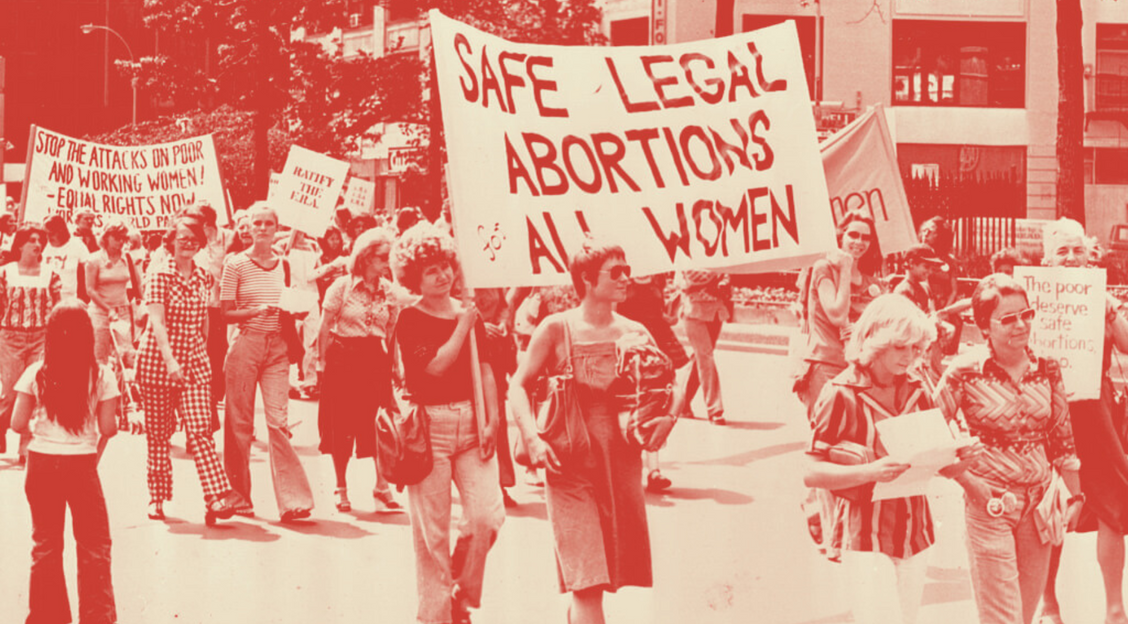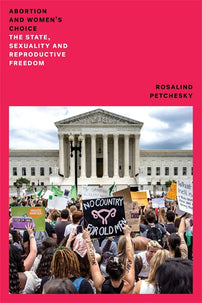Abortion Again?
Rosalind Petchesky reflects on the fight for reproductive rights forty years after the original publication of her book, Abortion and Women's Choice: The State, Sexuality and Reproductive Freedom.

Revisiting my book on abortion, first published some forty years ago, seems almost surreal. What does it mean when the political world swerves backward? When the fossils and ghosts of the past become the undead center of a very different yet repetitious present?
When Verso proposed a new edition of Abortion and Women’s Choice and invited me to write a preface for this moment, I had become a retired octogenarian whose earlier hopes for another world and liberated futures seemed as tired and achy as my body. The US Supreme Court’s cruel decision in Dobbs v. Jackson Women’s Health Organization in June of 2022 had eviscerated the ruling in Roe v. Wade of nearly fifty years earlier that abortion was a constitutional right. On cue, Dobbs unleashed a torrent of harsh measures in state courts and legislatures that not only criminalized abortion after six weeks or entirely but also threatened women’s (cis and trans) and trans men’s ability to access care for a wide range of pregnancy- and reproduction-related conditions, some of them life-threatening.
For abortion patients and their courageous medical providers, it’s guerrilla warfare every day, far worse in the southern and southwestern states, where reproductive health access has become almost nonexistent and inestimably worse for women of color and low-income women and girls.
Of course, the recent backlash against legal abortion has not happened in a vacuum, nor is it separate from a whole cluster of body politics and their macroeconomic/social/cultural contexts. In my 1990 preface, I wrote that ‘‘anti-abortion’’ had become ‘‘the fulcrum of a much broader ideological struggle’’ around a wide range of issues involving the meanings of family, state, gender, sexuality, and also religion, mass culture, race, and nation. If there was one theme that persisted through all my work across the decades, it was this idea that the politics of bodily self-determination could not be understood apart from what was going on in the local, national, and global arenas where individual racialized and gendered bodies are situated.
Further, the aspiration to have ‘‘control over my body’’ is at the heart of all movements for freedom, whether abolitionist, labor, queer, gay, feminist, antiracist, anticolonial, or disability related. It’s an idea that today has wide currency.
Methods of policing and surveillance to entrap and criminalize those who try to evade these draconian laws reprise colonial occupation forces, slave patrols, and Nazi totalitarianism. We have checkpoints at borders to stop medical refugees from physically crossing into states where abortion is still available; attempts by state attorneys-general in states with abortion bans to seize private medical records of their residents suspected of such border crossings; and online profiling to identify and jail those who seek and assist in the purchase of abortion pills— such as a mother and her teenage daughter imprisoned in Nebraska.
Texas’s SB 8 law— to which the Supreme Court’s far-right majority shamelessly gave a green light before Dobbs— institutes a form of Nazi-like vigilantism, offering a bounty to ordinary people who spy on and report neighbors, relatives, medical providers, Uber drivers— anyone involved in resistance to the Dobbs aftermath. In short, today’s abortion politics captures a large swath of citizens in the maw of advancing fascism in American society and expose it to the light.
Ever the optimist, I believe the wide sweep of policies to curtail bodily self-determination in the 2020s may also be the key to defeating them. Let’s look at a few sites where, at this writing, attacks on personal and collective freedoms in the US may be sowing the seeds of mass opposition. Take the US Supreme Court.
Today, with a 6–3 majority of far-right Republican-appointed justices (whose views reflect a bare minority of voters), the nation’s highest court has become, in Zillah Eisenstein’s words, ‘‘a rogue court’’ openly pushing a ‘‘radically antidemocratic agenda.’’ In 2023 alone, the court scored a trifecta of major victories for right-wing constituencies, smashing affirmative action, student debt relief, and respect for LGBTQ civil rights. That was on top of its crowning blow to reproductive rights and health in Dobbs in 2022.
These are decisions that already inflict grievous harm on millions of Americans based on their race, gender, class, and sexual/gender identity as well as their geographic location. They have met robust critiques on social and in mainstream media and within the court’s own liberal minority. Combined with growing reports about the justices’ personal corruption, they may well backfire through mass calls for reform, impeachment, and defiance.
Since Abortion and Women’s Choice was first published, Black feminist organizing around ‘‘reproductive justice’’— a term coined by a group of founding mothers including Loretta J. Ross, Toni M. Bond, and ten other Black women’s health activists in June 1994— has greatly advanced the main aim of this book: to frame abortion as one critical part of a much larger political and social agenda.
Through their outspoken voices and grassroots organizing, Black feminists in the SisterSong Women of Color Reproductive Justice Collective and their allies have illuminated the links between motherhood, health care access, social and economic inequality, and the persistent forces of racism and misogyny as a matrix that both encompasses and surpasses abortion. That work, in turn, has helped lay the ground for the mass protest that today’s siege on bodily self-determination calls us to.
Optimism, however, doesn’t mean denial. There is little doubt that all the harsh backward moves against sexual, gender, and reproductive justice in the contemporary US, even where they remain threats short of law, are having a terrifying, chilling effect. They intimidate young people and undocumented immigrants from seeking care, make health providers fearful of losing licenses or livelihoods or worse, and at the very least generate confusion about what is legal or illegal, where and what one risks by refusing to comply.
Dozens of clinics across the country have closed or stopped providing abortions. Pregnant people in Texas and elsewhere have faced near-death experiences because of the cruel refusal to allow abortions in cases of ectopic pregnancy, miscarriage, sepsis, gravely impaired fetuses, and other fatal conditions.
Even before Dobbs and more so after, women of color are over twice as likely to experience maternal morbidity or mortality than white women and more likely to be prosecuted for seeking access to self-managed abortion or using drugs while pregnant. Not only class, race, gender, and immigration status but also geographic location may determine your ability to access health and life-preserving services or to escape criminalization by the body police. ‘‘Choice,’’ as I argue in this book, has always been a socially contingent matter, and much more so for the most politically vulnerable groups. In 2023 in America, the language of ‘‘choice’’ seems quaint and anachronistic.
And yet, I remain optimistic for a number of reasons. On the abortion front, Amy Littlefield guides us through the maze of funds and underground services and medication pipelines that are helping people without means to acquire abortion pills or to travel and access the clinics and housing they need for safe and timely procedures:
The anti-abortion movement has yet to come up with a ban that can’t be circumvented by a plane trip or a road trip, or by someone handing a friend five white tablets that fit into the palm of their hand. The fatal flaw in the anti-abortion strategy is that plenty of people are still doing this work despite the risks.
Included in this loosely organized resistance movement are the thousands of courageous doctors, nurses, doulas, lay activists, and other caregivers who continue to risk their jobs and often their safety by providing reproductive and sexual health services either in clinics, through telemedicine, or, in some cases, clandestinely.
In the political arena, despite enormous divisions, there are also hopeful signs. Since Dobbs, midterm ballot measures involving abortion in seven different states— some of them solidly red and others with strong conservative leanings— have shown overwhelming popular support for safe, legal abortion in most circumstances among American voters of all political parties. Most Americans also support equal rights for LGBTQ people, racial equality, and an end to book bans and censorship at all levels of public education.
Of course, authoritarian regimes do not operate by public opinion polls. At this writing, the far right’s stronghold over many centers of power in the US— the Supreme Court and other federal courts, the House of Representatives, the Republican Party, state governments, corporate power, many media outlets, and religious groups— seriously challenges the remnants of democracy that remain in a society born of slavery, white supremacy, patriarchy, and capitalist oligarchy.
A presidential election in 2024 could spell the end of any façade of democratic institutions in this country, and all of it gives a boost to antidemocratic trends in countries across the globe. And yet (here I go, zigzagging again) I am still hopeful, most of all because of what I see as transformative demographics. For the generations born in the decades since this book was first published, so much has changed and become practically unrecognizable from when their parents and grandparents were young.
The internet and social media make it all but impossible to hide information about sexuality, contraception, abortion, gender and ethnic diversity, political criticism, and grassroots organizing. For countless urban and also rural youth, the old gender binary is as obsolete as Columbus Day, and the cornucopia of possible identities just keeps growing and shifting across life stages. These are expressions of bodily freedom beyond anything we feminists could have imagined forty years ago.
I wish my departed friends from our early days in the national and international campaigns for abortion and reproductive rights were here to experience this new day.
— An edited excerpt from Abortion and Women's Choice: The State, Sexuality and Reproductive Freedom by Rosalind Petchesky.
[book-strip index="1" style="buy"]
